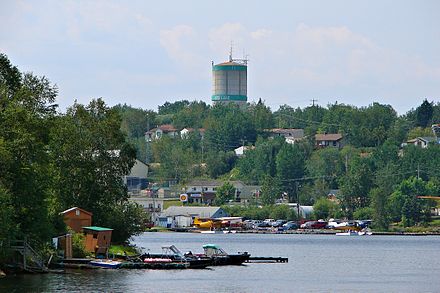Red Lake (Ontario) - town in Ontario, Canada
Red Lake is a town of 4,100 people (2016) in Northern Ontario. It is a regional transportation hub.
Understand

The three primary sources of employment in Red Lake are support services for the numerous mines surrounding the town, small scale logging and a tourism sector specializing in hunting and fishing. It is known as the "Norseman Capital of the World", referring to the Noorduyn Norseman aircraft which played a significant role in the development of the area.
The town acts as a cargo, passenger and tourism hub for Northwestern Ontario. With Pickle Lake, Red Lake serves over twenty northern fly-in communities.
History
The First Nations (Indigenous) people are believed to have inhabited the Red Lake area for 2,000 years. The first people to live in the land were members of the Sioux and Cree tribes. Approximately 200–300 years ago the Ojibwe people began to inhabit the area, effectively becoming the predominant people at the time.
In 1897, the R.J. Gilbert expedition discovered gold and staked 8 claims. However, the remoteness of the site precluded further exploration until 1922, when the town experienced a sudden surge of economic, industrial, and population growth. By 1936, Red Lake's Howey Bay was the busiest airport in the world, with more flights landing and taking off per hour than any other.
In 1995 Goldcorp, owners of the Red Lake Mine, discovered that it contains the world's richest grade gold ore (two troy ounces of gold per metric ton). Shortly thereafter, the mine suffered through a four-year-long miners' strike. Since then, the mine has become one of the richest gold mines in the world.
Climate
Snow usually starts falling around late October or early November, and starts melting around March but is not normally fully melted until late April, whilst late-season snow in May is not rare. This long winter is ideal for the local snowmobilers and for ice fishing though during this period, although the wind is often very cold and temperatures may drop to below −35 °C or −31 °F. During winter, residents and visitors participate in snowmobiling, ice fishing, skiing, ice hockey, and downhill sliding.
During the summer, the area experiences a moderate climate with little humidity, which is ideal for camping, boating, canoeing, and hiking.
Get in
By plane
- Red Lake Airport (IATA: YRL), 51.067222°, -93.793056°, +1 807 662-2581, airport@redlake.ca. Regular flights to Dryden, Sioux Lookout, Thunder Bay, and Winnipeg. Customs services are not available at this airport. Four airway companies take advantage of Red Lake's close proximity to the northern communities. North Star Air, Bearskin Airlines, Superior Airways, and Wasaya Airways operate out of YRL.
By bus
- Kasper Bus, +1-807-699-7200. Operates bus service in Northern Ontario and Manitoba. 2022-05-05 Operates a bus route multiple days per week between Winnipeg and Balmertown including stops in Kenora, Vermilion Bay, and Red Lake. Travel time to Red Lake from Winnipeg is 6. hours, from Kenora is 3.25 hours, and from Balmertown is 15 minutes.
By car
Take Highway 17 (the Trans-Canada Highway) to Vermilion Bay (west of Dryden), then take Highway 105 north for 175 km. area.
Red Lake is at the northern terminus of Highway 105. A short spur route, Highway 125, extends northerly from Highway 105 to the communities of Balmertown, Cochenour and McKenzie Island, while Highway 618 extends westerly from Highway 105 to the communities of Madsen and Starratt-Olsen.
Get around
See
- Eco-tourism is becoming popular in the area.
- Red Lake Regional Heritage Centre, 51A Highway 105, 51.0144°, -93.8215°, +1 807-727-3006, heritage@redlake.ca. M-F 9AM-5PM year round, Sa 10AM-4PM late May to Aug only, closed holidays. Heritage museum includes Aboriginal history, the fur trade, aviation and its role in the Red Lake gold rush, and mining. There is an exhibition of Woodland art, interactive kids' displays, and a well-stocked gift shop. Adults $3, seniors/students $2, children free 2018-11-28
Do
Red Lake is a prime location for summer sport fishing, as the lake contains several types of fish including walleye, northern pike, lake trout, whitefish and sauger. Other popular recreational summer activities include golfing at the Red Lake Golf and Country Club, swimming at Rahill and Kinsmen Beach, and even exploring the many bays and arms of Red Lake by boat.
Hunting attracts tourism, especially during the fall season. Red Lake is known for its abundance of game in the district, including moose, ruffed grouse, spruce grouse, duck, and bear. The gray wolf, white-tailed deer, red fox, beaver, and many bird species also inhabit the area.
Buy
Eat
- Antonio's, 212 Howey St, 51.0183°, -93.8276°, +1 807-727-3776. M-F 11AM-9PM, Sa 4PM-9PM. Italian restaurant. 9" pizza $10-16, pasta and salad $18-22, dinner with soup or salad $27-34 2018-11-28
- The Jade Restaurant, 17 Highway 105, 51.0178°, -93.8217°, +1 807 727-2777. 11AM-9PM. Chinese food, pizza, fried chicken, wings. 2018-11-28
- Spud & Dog, 213 Howey, +1 807 727-2659. Seasonal food truck with burgers, fries, poutine. 2018-11-29
Drink
Sleep
- The Howey Bay Motel, 26 Highway 105, 51.0183°, -93.8206°, +1 877-464-6939, info@thehowey.com. Free breakfast and free WiFi. Restaurant and bar. From $100 2018-11-28
- Nature's Inn Red Lake, 50 Detta Rd, Balmertown, +1 807 701-7126. Reception open 8AM-9PM, after hour check-in & late check out upon request. Wi-Fi. Pet-friendly rooms available. From $83 2018-11-29
- Balmer Hotel, 147 5 St., Balmertown, +1 807 735-2076. Simple, clean room. Restaurant and bar. 45 rooms. Courtesy shuttle to and from the airport. From $110 2018-11-29
- Super 8 by Wyndham, 11 Hughes Cresent, +1-800-536-1211. Free breakfast and free WiFi. From $100 2018-11-29
Connect
Go next
If you're driving, go back the way you came in to Vermilion Bay. If you're flying - especially in a float plane - the entire Kenora District is yours to discover.
- Pimachiowin Aki, a UNESCO World Heritage Site that straddles the Ontario-Manitoba border.
Red Lake
red-lake.comDate Time:Please wait...Timezone:America/WinnipegPopulation:4,107Coordinates:51.02, -93.83
Kenora District
2nd-order administrative division
Ontario
Primary administrative division